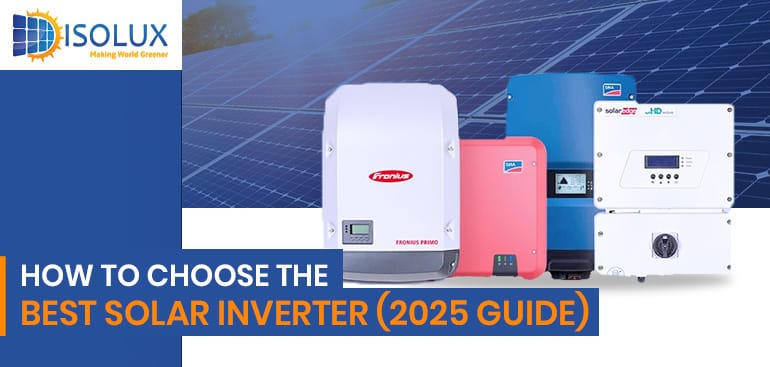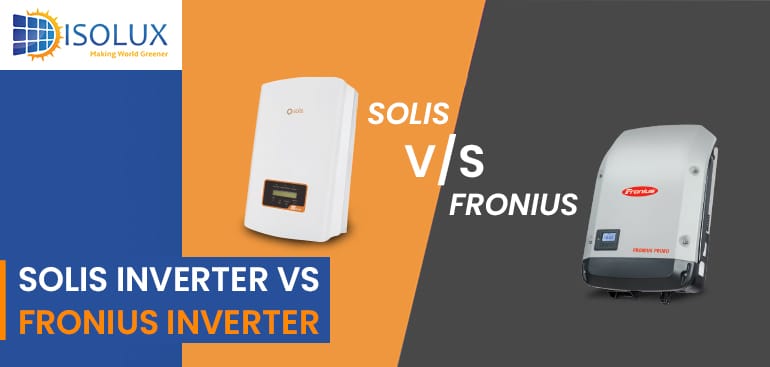Going solar is one of the smartest things you can do. It helps lower your electricity bill. It’s also great for the planet. But when most people go solar, they focus only on the panels. That’s a mistake. One of the most important parts of your system is the solar inverter.
The inverter is the brain of your solar setup. It takes power from the sun and makes it usable for your home. In this blog, we’ll help you understand what a solar inverter does, the different types, and how to pick the right one.
What Does a Solar Inverter Do?
Solar panels create electricity as DC (direct current). But your home uses AC (alternating current). That’s where the inverter comes in. It converts the high-voltage DC power (up to 1,000 volts) into 230V AC, which powers your lights, fridge, and other appliances.
A good inverter does more than just convert power. It also:
- Finds the best power output from your solar panels every second.
- Follows the rules set by your local power grid.
- Stops sending power back to the grid if needed.
- Talks to your appliances, like your EV charger or battery, to save power.
In short, don’t buy the cheapest inverter. It won’t give you the same efficiency or lifespan. A better inverter means better performance and more savings in the long run.
Types of Solar Inverters
There are several kinds of inverters. The best one for you depends on your roof, your budget, and whether you plan to get batteries later.
1. String Inverters
This is the most common type. It’s a single box mounted near your meter. All your solar panels connect to it.
2. Microinverters
These are small inverters that sit under each solar panel. Think of them as giving each panel its own brain.
- Great for roofs with shade or different angles.
- Safer because they run on low voltage.
- Best brand: Enphase.
Microinverters cost more, but they are worth it if you have a tricky roof.
3. Optimized String Inverters
These are like regular string inverters but with added “optimizers” on each panel.
- Better for shade or complex layouts.
- Good brand: SolarEdge.
4. Hybrid Inverters
Hybrid inverters are string inverters that also work with batteries.
- Great if you plan to add batteries in the next two years.
- Saves you money by avoiding a second battery inverter.
- Brands to consider: Sungrow, Fronius.
5. Modular Hybrid Inverters (New in 2025)
These are stackable units. You can add a battery or EV charger later without rewiring.
- Very flexible and easy to expand.
- Top brand: Sigenergy.
What to Look for in a Solar Inverter
Buying the right inverter is not just about the type. Here are a few things to keep in mind before choosing one.
Check if It’s Approved
In Australia, your inverter must be on the Clean Energy Council’s approved list. If it’s not, avoid it.
Local Support Matters
Pick a brand with an office in Australia. If something goes wrong, you want fast service. Dealing with overseas support is a nightmare.
Get the Right Size
You can connect more panel power than the inverter’s rated output. This is called “oversizing”:
- Without batteries: up to 33% more.
- With batteries: up to 100% more (brand rules apply).
More panels mean more energy in the morning, evening, and cloudy days.
Installation Location
Put your inverter in a cool, shaded place. Heat kills electronics. Best location: garage. If not, next to your meter box with a shade cover (costs $200–$300).
Warranty
Good inverters last 10–20 years. Cheap ones may not last 10. Look for warranties of 10 years or more. And always read the fine print.
Smart Monitoring
Most inverters come with an app. This lets you see how much power you’re making and using. Premium apps show more details, like how much of your home is using solar vs grid power.
Solar Inverter Comparison Table (2025)
| Inverter Type | Best For | Key Benefits | Approx. Price Range (AUD) | Recommended Brands |
|---|---|---|---|---|
| String Inverter | Simple roof with few shading issues | Cost-effective, reliable, easy to maintain | $1,200 – $2,000 | GoodWe, Fronius |
| Microinverter | Roofs with shade, multiple directions/slopes | Maximizes each panel’s output, safer (low voltage) | $5,000 – $6,500 (Enphase IQ8) | Enphase |
| Optimized String | Partially shaded or complex layouts | Combines string efficiency with panel-level optimization | $3,800 – $5,000 | SolarEdge |
| Hybrid Inverter | Systems planning to add a battery soon | Battery-ready, avoids needing a separate battery inverter | $3,000 – $4,500 | Sungrow, Fronius, Sigenergy |
| Modular Hybrid (2025) | Future-proof setups with EV/battery plans | Stackable, easy to expand without rewiring | $4,500 – $6,000+ | Sigenergy |
What Does It Cost?
Better inverters cost more. But it’s often worth it.
Here’s a rough idea for a 10kW system:
- Budget inverter (GoodWe): base price.
- Mid-range (Sungrow, Sigenergy): add $2,500.
- Premium (Fronius): add $2,500+.
- Microinverters (Enphase): add $4,000 or more.
Paying more now can save you repair costs and performance issues later.
Final Tips
- Only get Enphase microinverters if you truly need them.
- Match your inverter size to your panels and battery plans.
- Don’t install in full sun without a shade cover.
- Spend a little more for mid-range or premium. Cheap ones often disappoint.
Ready to Install?
If you’re serious about solar, don’t skip on the inverter. It’s the most important piece of your system. A good inverter means better savings, safer energy, and a stress-free setup.
Need help choosing the right inverter? Get trusted quotes from local installers from isolux.com.au.
FAQ
What does a solar inverter do?
A solar inverter converts the DC electricity generated by your solar panels into AC electricity used by home appliances. It also helps optimize power output and ensures your system follows local energy regulations.
Which type of solar inverter is best for shaded roofs?
Microinverters or optimized string inverters are best for shaded or complex roofs. They let each panel work independently, so shade on one panel doesn’t affect the others.
Do I need a hybrid inverter?
You need a hybrid inverter if you plan to add batteries within the next 1–2 years. It simplifies the setup and saves money by avoiding a second battery inverter.
How long do solar inverters last?
Good quality solar inverters last between 10 and 20 years. Budget models often last less than 10 years. Always check the warranty and support availability in your country.
Are microinverters worth the extra cost?
Microinverters are worth the extra cost if your roof has shading issues, multiple angles, or if you want a safer low-voltage system. Otherwise, a quality string inverter is enough for most homes.




